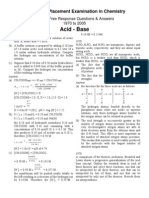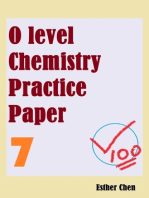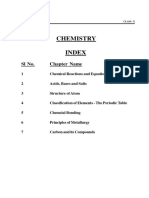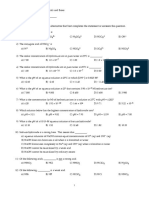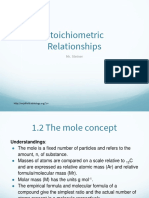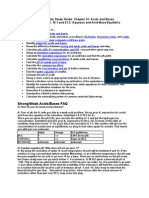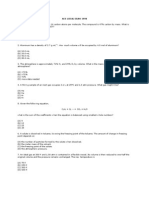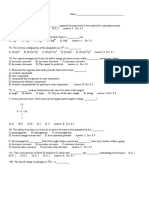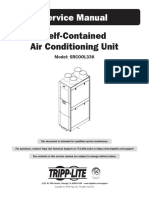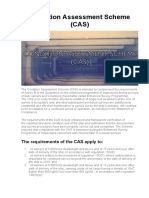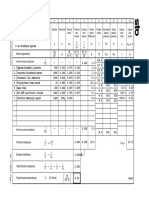0 ratings0% found this document useful (0 votes)
994 viewsSAT II Chemistry Practice Test 1
SAT II Chemistry Practice Test 1
Uploaded by
Jaime DianzonThis document provides a practice test for SAT chemistry with multiple choice questions covering various chemistry concepts. It begins with 25 questions (For 1-25) testing understanding of organic compounds, chemical reactions, quantum mechanics principles, and properties of elements. The next set of 10 questions (For 26-35) provides statements to evaluate as true or false. Further multiple choice questions then assess additional topics like equilibrium, stoichiometry, atomic structure, thermodynamics, and gas properties.
Copyright:
Attribution Non-Commercial (BY-NC)
Available Formats
Download as PDF, TXT or read online from Scribd
SAT II Chemistry Practice Test 1
SAT II Chemistry Practice Test 1
Uploaded by
Jaime Dianzon0 ratings0% found this document useful (0 votes)
994 views4 pagesThis document provides a practice test for SAT chemistry with multiple choice questions covering various chemistry concepts. It begins with 25 questions (For 1-25) testing understanding of organic compounds, chemical reactions, quantum mechanics principles, and properties of elements. The next set of 10 questions (For 26-35) provides statements to evaluate as true or false. Further multiple choice questions then assess additional topics like equilibrium, stoichiometry, atomic structure, thermodynamics, and gas properties.
Original Description:
SAT II Chemistry Practice Test
Copyright
© Attribution Non-Commercial (BY-NC)
Available Formats
PDF, TXT or read online from Scribd
Share this document
Did you find this document useful?
Is this content inappropriate?
This document provides a practice test for SAT chemistry with multiple choice questions covering various chemistry concepts. It begins with 25 questions (For 1-25) testing understanding of organic compounds, chemical reactions, quantum mechanics principles, and properties of elements. The next set of 10 questions (For 26-35) provides statements to evaluate as true or false. Further multiple choice questions then assess additional topics like equilibrium, stoichiometry, atomic structure, thermodynamics, and gas properties.
Copyright:
Attribution Non-Commercial (BY-NC)
Available Formats
Download as PDF, TXT or read online from Scribd
Download as pdf or txt
0 ratings0% found this document useful (0 votes)
994 views4 pagesSAT II Chemistry Practice Test 1
SAT II Chemistry Practice Test 1
Uploaded by
Jaime DianzonThis document provides a practice test for SAT chemistry with multiple choice questions covering various chemistry concepts. It begins with 25 questions (For 1-25) testing understanding of organic compounds, chemical reactions, quantum mechanics principles, and properties of elements. The next set of 10 questions (For 26-35) provides statements to evaluate as true or false. Further multiple choice questions then assess additional topics like equilibrium, stoichiometry, atomic structure, thermodynamics, and gas properties.
Copyright:
Attribution Non-Commercial (BY-NC)
Available Formats
Download as PDF, TXT or read online from Scribd
Download as pdf or txt
You are on page 1of 4
SAT chem.
Review Practice test 1
For 1 4:
a. CH3CH2CH2OH
b. CH3CH(Br)CH(Br)CH3
c. CH3CH2CH(Br)CH3
d. CH3CH2CH2COOH
e. CH3CH2CH2CH3
1. CH3CH=CHCH3 + H2 1.
2. 1. + Br2 HBr + 2.
3. CH3CH=CHCH3 + Br2 3.
4. Which compound would most likely
turn litmus paper to a red color?
For 5 8:
a. Heisenberg Uncertainty
principle
b. Pauli Exclusion Principle
c. Schrodinger Wave Equation
d. Hund's Rule
e. Bohr model of the hydrogen
atom
5. No two electrons can have the
same quantum number because
they must have opposite spins.
6. We cannot know the exact location
of an electron in space.
7. The electrons will occupy an orbital
singly, with parallel spins, before
pairing up.
8. The energy changes that an
electron may undergo are
quantized.
For 9 12:
a. H2
b. CO2
c. H2O
d. NaCl
e. CH2CH2
9. Contains just one sigma bond
10. Has a bond formed from the
transfer of electrons
11. Has an atom that is sp hybridized
12. Is a polar molecule
For 13 16:
a. F
b. Li
c. Fe
d. He
e. Si
13. Shows both the properties of both
metals and non-metals
14. Has the greatest ionization energy
15. Has the greatest electronegativity
16. Has colored salts that will produce
colored aqueous solutions
For 17 19:
a. NaC2H3O2
b. HC2H3O2
c. KCl
d. NH3
e. HCl
17. Is a salt that will undergo hydrolysis
to form a basic solution
18. Will form a coordinate covalent
bond with a hydronium ion
19. Is a strong acid
For 20 22:
a. q = mcT
b. q = Hvm
c. P1V1 = P2V2
d. D = m/V
e. K = C + 273
20. Can be used to find the mass of an
irregularly shaped solid
21. Boyle's Law
22. Used to find energy gained or lost
during a particular phase change.
For 23 25:
a. Alpha particle
b. Beta particle
c. Neutron
d. Gamma ray
e. Positron
23. Has the greatest mass
24. Has the greatest positive charge
25. Has the same mass and charge as
an electron
Q Statement I Because Statement II
26.
12
C is an isotope of
14
C Because The nuclei of both atoms have the same number of
neutrons
27. Ne is an inert gas Because Ne has a complete octet in its valence shell
28. A solution with a pH of 5 is less acidic than a solution with
a pH of 8
Because A solution with a pH of 5 has 1000 times more hydronium
ions than a solution with a pH of 8
29. A reaction with a positive H is considered to be
exothermic
Because An exothermic reaction has more heat released than
absorbed
30. A voltaic cell spontaneously converts chemical energy into
electrical energy
Because A voltaic cell needs an externally applied current to work
31. K is considered to be a metal Because When K becomes an ion its atomic radius increases
32. At equilibrium the concentration of reactants and products
remain constant
Because At equilibrium the rates of the forward and reverse
reactions are equal
33. Powdered zinc will react faster with HCl than one larger
piece of zinc of the same mass
Because Powdered zinc has less surface area than one larger
piece of zinc of the same mass
34. An organic compound with the molecular formula C4H10
can exist as two compounds
Because n-butane and 2-methylpropane are isomers that have the
molecular formula of C4H10
35. At STP, 22.4 liters of He will have the same volume as
one mole of H2 (assume ideal gases)
Because One mole or 22.4 liters of any gas at STP will have the
same mass
36. Halogen molecules can exist as solids, liquids or gases at
room temperature
Because As nonpolar molecules are considered by increasing mass
the dispersion forces between them increases
37. Hydrocarbons will dissolve in water Because Substances that have the same polarity are miscible and
can dissolve each other
38. Ammonia has a trigonal pyramidal molecular geometry Because Ammonia has a tetrahedral electron pair geometry with
the three atoms bonded to the central atom
39. AlCl3 is called aluminum trichloride Because Prefixes are used when naming covalent compounds
40. When a Li atom reacts and becomes an ion, the Li atom
can be considered to be a reducing agent
Because The Li atom lost an electron and was oxidized
41. 117 grams of NaCl are dissolved in
water to make 500 mL of solution.
Water is then added to this solution
to make a total of one liter of
solution. The final molarity of the
solution will be
a. 4 M
b. 2 M
c. 1 M
d. 0.5 M
e. 0.585 M
42. How many pi bonds are in the
molecule 2-butyne, CH3C=CCH3?
a. 1
b. 2
c. 4
d. 6
e. 10
43. How many atoms lie in a straight
line in the molecule 2-butyne,
CH3C=CCH3?
a. 10
b. 8
c. 6
d. 4
e. 2
44. A solution of a weak acid, HA, has
a concentration of 0.100 M. What
is the concentration of hydronium
ion and the pH of this solution if the
Ka value for this acid is 1.0 x 10
-5
?
a. 1.0 x 10
-3
and pH = 11
b. 1.0 x 10
-6
and pH = 6
c. 1.0 x 10
-4
and pH = 8
d. 3.0 x 10
-4
and pH = 4
e. 1.0 x 10
-3
and pH = 3
45. Given the reaction at STP: Mg(s) +
2HCl(aq) MgCl2(aq) + H2(g),
how many liters of H2(g) can be
produced from the reaction of
12.15 g Mg and excess HCl(aq)?
a. 2.0 L
b. 4.0 L
c. 11.2 L
d. 22.4 L
e. 44.8 L
46. A student performed a single
titration using 2.00 M HCl to
completely titrate 40.00 mL of 1.00
M NaOH. If the initial reading on
the buret containing HCl was 2.05
mL, what will be the final reading?
a. 82.05 mL
b. 42.05 mL
c. 20.00 mL
d. 10.00 mL
e. 22.05 mL
47. Which of the following was NOT a
conclusion of Rutherford's gold foil
experiment?
a. The atom is mainly empty
space
b. The nucleus has a negative
charge
c. The atom has a dense
nucleus
d. Alpha particles can pass
through a thin sheet of gold
foil
e. All of the above are correct
regarding the gold foil
experiment
48. In a reaction the potential energy of
the reactants is 40 kJ/mol, the
potential energy of the products is
10 kJ/mol and the potential energy
of the activated complex is 55
kJ/mol. What is the activation
energy for the reverse reaction?
a. 45 kJ/mol
b. -30 kJ/mol
c. 15 kJ/mol
d. 35 kJ/mol
e. -55 kJ/mol
49. Which reactions would form at
least one solid precipitate as a
product? Assume aqueous
reactants.
i. AgNO3 + NaCl NaNO3 + AgCl
ii. Pb(NO3)2 + 2KI PbI2 + 2KNO3
iii. 2NaOH + H2SO4 Na2SO4 + 2H2O
a. i only
b. ii only
c. iii only
d. i and ii only
e. ii and iii only
50. What is the mass action equation
for 2A(aq) + B(aq) 3C(aq) + D(s)
a.
b.
c.
d.
e.
51. If the equilibrium constant for a
reverse reaction is 9.0 x 10
-4
, what
is the equilibrium constant for the
forward reaction?
a. 3.0 x 10
-2
b. -3.0 x 10
-2
c. -9.0 x 10
-2
d. 1 / 9.0 x 10
-4
e. 1 / -9.0 x 10
-4
52. A compound's composition by
mass is 50% S and 50% O. What
is the empirical formula of this
compound?
a. SO
b. SO2
c. S2O
d. S2O3
e. S3O4
53. What percentage of the total mass
of KHCO3 is made up by
nonmetallic elements?
a. 17%
b. 83%
c. 61%
d. 20%
e. 50%
54. Which aqueous solution is
expected to have the highest
boiling point?
a. 0.2 m CaCl2
b. 0.2 m NaCl
c. 0.1 m AlCl3
d. 0.2 m CH3OH
e. 0.2 m NaC2H3O2
55. Which of the following solids are known
to undergo sublimation?
i. CO2
ii. I2
iii. Napthalene
a. i only
b. ii only
c. i and ii only
d. ii and iii only
e. i, ii and iii
56. Which of the following demonstrates a
decrease in entropy?
a. Dissolving a solid into a solution
b. An expanding universe
c. Burning a log in a fireplace
d. Raking up leaves into a trash bag
e. Spilling a glass of water
57. Which of the following substances is/are
liquid(s) at room temperature?
i. Hg
ii. Br2
iii. Si
a. i only
b. ii only
c. i and ii only
d. ii and iii only
e. i, ii and iii
58. Which of the following would be
considered to be unsafe in a laboratory
setting?
a. Using a test tube holder to handle
a hot test tube
b. Tying one's long hair back before
experimenting
c. Wearing open-toed shoes
d. Pouring liquids while holding the
reagent bottles over the sink
e. Working under a fume hood
59. A sample of a gas at STP contains 3.01
x 10
23
molecules and has a mass of
20.0 grams. This gas would
a. have a molar mass of 20.0 g/mol
and occupy 11.2 liters
b. occupy 22.4 liters and have a
molar mass of 30.0 g/mol
c. occupy 22.4 liters and have a
molar mass of 20.0 g/mol
d. have a molar mass of 40.0 g/mol
and occupy 33.6 liters
e. have a molar mass of 40.0 g/mol
and occupy 11.2 liters
60. Given the reaction: Ca(s) + Cl2(g)
CaCl2(s), when 80 g Ca (molar mass is
40) is reacted with 213 g Cl2 (molar
mass is 71) one will have
a. 40 g Ca excess
b. 71 g Cl2 excess
c. 293 g CaCl2 formed
d. 133 g CaCl2 formed
e. 113 g CaCl2 formed
61. A student performed an experiment to
determine the solubility of a salt at
various temperatures. The data from
the experiment can be seen below:
Trial Temp (
o
C) Solubility in 100
g water
1 20 44
2 30 58
3 40 67
4 50 62
5 60 84
Which trial seems to be in error?
a. 1
b. 2
c. 3
d. 4
e. 5
62. Given the following reaction at
equilibrium: 3H2(g) + N2(g)
2NH3(g) + heat energy, which of
the following conditions would shift
the equilibrium of this reaction so
that the formation of ammonia is
favored?
a. Increasing the pressure of the
reaction
b. Heating the reaction
c. Removing hydrogen gas from
the reaction
d. Adding more ammonia to the
reaction
e. Removing nitrogen gas from
the reaction
63. Given equal conditions, which gas
below is expected to have the
greatest density?
a. H2
b. Ne
c. Ar
d. H2S
e. Cl2
64. Given equal conditions, which gas
below is expected to have the
greatest rate of effusion?
a. H2
b. Ar
c. Kr
d. F2
e. Cl2
65. Ideal gases
a. Have forces of attraction
between them
b. Are always linear in shape
c. Never travel with a straight
line motion
d. Have molecules that are close
together
e. Have low masses and are
spread far apart
66. Which substance will combine with
oxygen gas to produce a
greenhouse gas?
a. Na
b. S
c. H2
d. Ne
e. C
67. Which general formula below
represents that of an organic
ester?
a. ROH
b. RCOOH
c. ROR
d. RCOOR
e. RCOR
68. When an alkaline earth metal, M,
reacts with oxygen the formula of
the compound produced will be
a. M2O
b. MO
c. M2O3
d. MO2
e. M3O4
69. A catalyst can change the
a. Heat of reaction and the
potential energy of the
reactants
b. Heat of reaction and the time
it takes the reaction to
proceed
c. Activation energy of the
reverse reaction and the
potential energy of the
activated complex
d. Potential energy of the
reactants and the time it takes
the reaction to proceed
e. Activation energy of the
forward reaction and the
potential energy of the
products
70. A neutral atom has a total of 17
electrons. The electron
configuration in the outermost
principle energy level will look
closest to
a. 1s
2
2s
2
2p
5
b. 3s
5
3p
2
c. s
2
p
5
d. s
2
p
8
d
7
e. sp
7
71. Given a 22.4 liter sample of helium
gas at STP, if the temperature is
increased by 15 degrees Celsius
and the pressure changed to 600
torr, what would the new volume
be?
a. (760)(22.4)(15) / (273)(600)
b. (273)(600)(288) / (760)(22.4)
c. (760)(22.4)(15) / (600)
d. (760)(22.4)(288) / (273)(600)
e. (273)(600) / (760)(22.4)(288)
72. Which of the following are correct
about the subatomic particles
found in
37
Cl
1-
?
i. 21 neutrons
ii. 17 protons
iii. 16 electrons
a. ii only
b. iii only
c. i and ii only
d. i and iii only
e. ii and iii only
73. A hydrated blue copper(II) sulfate
salt with a formula YCuSO4XH2O
is heated until it is completely white
in color. The student who
performed the dehydration of this
salt took note of the mass of the
sample before and after heating
and recorded it as follows:
Mass of hydrated salt = 500 g
Mass of dehydrated salt = 320 g
What is the value of "X in the formula of
the hydrated salt?
a. 1
b. 2
c. 4
d. 5
e. 10
74. Which of the following oxides can
dissolve in water to form a solution that
would turn litmus indicator red in color?
a. MgO
b. K2O
c. CO2
d. ZnO
e. H2O
75. The process in which water vapor
changes phase to become liquid is
called
a. Deposition
b. Sublimation
c. Vaporization
d. Fusion
e. condensation
76. What is the value for H for the reaction
N2O4 2NO2 given the following:
2NO2 N2 + 2O2 H = -16.2 kcal
N2 + 2O2 N2O4 H = +2.31 kcal
a. +13.89 kcal
b. +18.51 kcal
c. +37.42 kcal
d. -13.89 kcal
e. -18.51 kcal
77. A liquid will boil when
a. Enough salt has been added to it
b. The vapor pressure of the liquid is
equal to the atmospheric or
surrounding pressure
c. The vapor pressure of the liquid
reaches 760 mmHg
d. Conditions favor the liquid's
molecules to be closer together
e. It has been brought up to a higher
elevation
78. A conductivity experiment is set up with
a light bulb and five beakers of 0.1 M
solutions of the substances below.
Which solution would allow the bulb to
glow the brightest?
a. C6H12O6
b. HCl
c. SiO2
d. HC2H3O2
e. CH3OH
79. Which of the following represents a
correctly balanced half-reaction?
a. Cl2 + 2e
-
Cl
-
b. 2e
-
+ Fe Fe
2+
c. O2 2e
-
+ 2O
2-
d. Al
3+
Al + 3e
-
e. 2H
+
+ 2e
-
H2
80. A student prepares for an experiment
involving a voltaic cell. Which of the
following is needed the least to perform
the experiment?
a. Buret
b. Salt bridge
c. Strip of zinc metal
d. Copper wire
e. Solution of zinc sulfate
81. When the equation : __C3H8 +
__O2 __CO2 + __H2O is
balanced using the lowest whole
number coefficients, the coefficient
before O2 will be
a. 1
b. 2.5
c. 5
d. 10
e. 13
82. Which nuclear equation below
demonstrates beta decay?
a.
238
U
234
Th + X
b.
1
H + X
3
H
c.
14
N + X
17
O +
1
H
d.
234
Pa
234
U + X
e. None of the above
demonstrate beta decay
83. Which of these processes could be
associated with the following
reaction: 2H2O 2H2 + O2
i. electrolysis
ii. neutralization
iii. decomposition
a. i only
b. iii only
c. i and iii only
d. i and ii only
e. ii and iii only
84. The following reaction occurs in a
beaker: Ag
+
(aq) + Cl
-
(aq)
AgCl(s). If a solution of sodium
chloride were added to this beaker
a. The solubility of the sodium
chloride would decrease
b. The reaction would shift to the left
c. The concentration of silver ions in
solution would increase
d. The solubility of the silver chloride
would decrease
e. The equilibrium would not shift at
all
85. How many atoms are represented in the
equilibrium Pb(NO3)2 + 2KI PbI2 +
2KNO3?
a. 5
b. 12
c. 13
d. 18
e. 26
ANSWERS:
1. E
2. C
3. B
4. D
5. B
6. A
7. D
8. E
9. A
10. D
11. B
12. C
13. E
14. D
15. A
16. C
17. A
18. D
19. E
20. D
21. C
22. B
23. A
24. A
25. B
26. T F
27. T T CE
28. F T
29. F T
30. T F
31. T F
32. T T CE
33. T F
34. T T CE
35. T F
36. T T CE
37. F T
38. T T CE
39. F T
40. T T CE
41. B
42. B
43. D
44. E
45. C
46. E
47. B
48. A
49. D
50. A
51. D
52. B
53. C
54. A
55. E
56. D
57. C
58. C
59. E
60. B
61. D
62. A
63. E
64. A
65. E
66. E
67. D
68. B
69. C
70. C
71. D
72. A
73. D
74. C
75. E
76. A
77. B
78. B
79. E
80. A
81. C
82. D
83. C
84. D
85. E
SCORE SHEET*
Number of questions right = __________
Less ! x number of wrong = __________ (NOTE: Omitted questions are not counted as wrong.)
Equals raw score = __________
Raw Actual Raw Actual Raw Actual Raw Actual Raw Actual
85 800 63 710 41 570 19 440 -3 300
84 800 62 700 40 560 18 430 -4 300
83 800 61 700 39 560 17 430 -5 290
82 800 60 690 38 550 16 420 -6 290
81 800 59 680 37 550 15 420 -7 280
80 800 58 670 36 540 14 410 -8 270
79 790 57 670 35 530 13 400 -9 270
78 790 56 660 34 530 12 400 -10 260
77 790 55 650 33 520 11 390 -11 250
76 780 54 640 32 520 10 390 -12 250
75 780 53 640 31 510 9 380 -13 240
74 770 52 630 30 510 8 370 -14 240
73 760 51 630 29 500 7 360 -15 230
72 760 50 620 28 500 6 360 -16 230
71 750 49 610 27 490 5 350 -17 220
70 740 48 610 26 480 4 350 -18 220
69 740 47 600 25 470 3 340 -19 210
68 730 46 600 24 470 2 330 -20 210
67 730 45 590 23 460 1 330 -21 200
66 720 44 580 22 460 0 320
65 720 43 580 21 450 -1 320
64 710 42 570 20 440 -2 310
*NOTE:
The conversion chart here is only an
approximation. Since the conversion
changes every year with a new test, this
chart gives an estimate that is most likely
within 10 points of the actual score.
You might also like
- Ee 231 - Electric Circuits 1Document31 pagesEe 231 - Electric Circuits 1Kene LawNo ratings yet
- Acids and Bases Lecture 1 (Grade 9)Document13 pagesAcids and Bases Lecture 1 (Grade 9)Waleed SaifNo ratings yet
- KKS StandardDocument20 pagesKKS Standardforuzz100% (2)
- CHEM 142 Experiment #4: Calibration Curves and An Application of Beer's LawDocument4 pagesCHEM 142 Experiment #4: Calibration Curves and An Application of Beer's LawericaNo ratings yet
- Ap Chem Free Response Answers Acid BaseDocument20 pagesAp Chem Free Response Answers Acid BaseChristina Nguyen50% (2)
- EmSAT Chemistry College Entry Exam Specification English PDFDocument2 pagesEmSAT Chemistry College Entry Exam Specification English PDFOmar Shamayleh100% (1)
- CISSP My - Nots PDFDocument11 pagesCISSP My - Nots PDFMarc Anthony N100% (1)
- MVP 50T STCDocument3 pagesMVP 50T STCAlexander GraytrousesNo ratings yet
- Chemistry Practice Test 3Document14 pagesChemistry Practice Test 3Mirza Muhammad Musaab0% (1)
- CH 9 and 10 AP Part 2 AnswersDocument7 pagesCH 9 and 10 AP Part 2 AnswersjohntheuglyllamaNo ratings yet
- SAT Subject Test - Chemistry - Diagnostic Test - LearningpodDocument29 pagesSAT Subject Test - Chemistry - Diagnostic Test - Learningpodarshad_bah100% (2)
- Chemistry Sat Tips and Tricks For The Sat II Chemistry Ap Exam Chemistry Sat Tips and Tricks For The Sat II Chemistry ApDocument2 pagesChemistry Sat Tips and Tricks For The Sat II Chemistry Ap Exam Chemistry Sat Tips and Tricks For The Sat II Chemistry ApSick Jays0% (1)
- Chemistry SATDocument26 pagesChemistry SATpavanmadhav.kNo ratings yet
- 12th Class Guess Papers 2024 Chemistry McqsDocument10 pages12th Class Guess Papers 2024 Chemistry McqsMuhammad HaseebNo ratings yet
- Practice Exam 1st Tri Multiple Choice 2016-2017 - KeyDocument7 pagesPractice Exam 1st Tri Multiple Choice 2016-2017 - KeyJohn YuanNo ratings yet
- A2-Chemistry Unit 5 Sample PaperDocument22 pagesA2-Chemistry Unit 5 Sample PaperDimuthu SandaruwanNo ratings yet
- AP Chemistry MC WorkshopDocument6 pagesAP Chemistry MC WorkshopSNIGDHA PATLOLANo ratings yet
- Term 1 Mcqs Series Solid StateDocument108 pagesTerm 1 Mcqs Series Solid StateshubhamNo ratings yet
- C6 Electrolysis QuestionsDocument19 pagesC6 Electrolysis QuestionsParam BhimaniNo ratings yet
- APCHEM Review Practice Test 1Document16 pagesAPCHEM Review Practice Test 1M. JosephNo ratings yet
- Chapter 4 Practice Test 4u1Document4 pagesChapter 4 Practice Test 4u1helloblargNo ratings yet
- 7 Stoichiometric RelationshipsDocument77 pages7 Stoichiometric RelationshipsLuka MaroNo ratings yet
- AP Chemistry Study Guide: Chapter 14: Acids and Bases and Chapter 15, 16.1 and 21.3: Aqueous and Acid-Base EquilibriaDocument8 pagesAP Chemistry Study Guide: Chapter 14: Acids and Bases and Chapter 15, 16.1 and 21.3: Aqueous and Acid-Base Equilibrialorraine_cuaNo ratings yet
- Multiple Choice QuestionsDocument39 pagesMultiple Choice QuestionsFatma JamalNo ratings yet
- CHEM 121 Midterm Practice Questions 2013Document13 pagesCHEM 121 Midterm Practice Questions 2013Kathryn CruzNo ratings yet
- Chemistry SatDocument17 pagesChemistry SatAriana GameroNo ratings yet
- Grade 12 Practice QuestionsDocument10 pagesGrade 12 Practice Questionsnahil ahmedNo ratings yet
- Ap23 Apc Chemistry q1Document15 pagesAp23 Apc Chemistry q1Dylan DanovNo ratings yet
- Organic Reaction: Addition Substitution Elimination RearrangementDocument39 pagesOrganic Reaction: Addition Substitution Elimination RearrangementJulJayaNo ratings yet
- Chemistry Final Exam 1 - 2012Document11 pagesChemistry Final Exam 1 - 2012Alex HwangNo ratings yet
- Electrochemistry Test From Online Source AnswersDocument32 pagesElectrochemistry Test From Online Source AnswersglaubersgNo ratings yet
- AP IMF QP (NEW) 的副本Document69 pagesAP IMF QP (NEW) 的副本任思诗No ratings yet
- AP Chem Unit 4 Progress CheckDocument34 pagesAP Chem Unit 4 Progress CheckJogesh VermaNo ratings yet
- Carboxylic Acids (Multiple Choice) QPDocument5 pagesCarboxylic Acids (Multiple Choice) QPGovind ShankarNo ratings yet
- 2013 Chemistry (Stage 3) ExamDocument44 pages2013 Chemistry (Stage 3) ExamMichael BobNo ratings yet
- Ap Unit6 WorksheetDocument4 pagesAp Unit6 Worksheetburcak gecNo ratings yet
- Predicting Reaction NotesDocument4 pagesPredicting Reaction NotesCindy MoNo ratings yet
- TB - 84AcidBasereactions Andbuffer - 61edfa34b42c35.61edfa364a8f42.17960494 PDFDocument7 pagesTB - 84AcidBasereactions Andbuffer - 61edfa34b42c35.61edfa364a8f42.17960494 PDF任思诗No ratings yet
- 2010 GCSE Maths For AQADocument2 pages2010 GCSE Maths For AQAMohammad Tayyab KhanNo ratings yet
- H432-01-Periodic Table, Elements and Physical Chemistry/a Level Chemistry A H432 - H432-01 - QS13Document5 pagesH432-01-Periodic Table, Elements and Physical Chemistry/a Level Chemistry A H432 - H432-01 - QS13Altay ShawNo ratings yet
- Preliminary Idea of Reaction MechanismDocument15 pagesPreliminary Idea of Reaction MechanismSiddhant SahNo ratings yet
- June 2016 QP - Unit 1 OCR Chemistry A-LevelDocument16 pagesJune 2016 QP - Unit 1 OCR Chemistry A-Levelmark sjsieuNo ratings yet
- GRE Combination QuestionsDocument9 pagesGRE Combination Questionsaslamkatohar100% (1)
- Acs Local Exam 1990Document10 pagesAcs Local Exam 1990kateexdNo ratings yet
- Ques202 295bon2mcDocument13 pagesQues202 295bon2mcMuhammad HaneefNo ratings yet
- Chem Topic 4 QuestionsDocument19 pagesChem Topic 4 QuestionsOscarHigson-SpenceNo ratings yet
- 2021 JC2 Prelim H1 Chemistry Paper 1 QPDocument12 pages2021 JC2 Prelim H1 Chemistry Paper 1 QPShengxin PanNo ratings yet
- Unit 1 Questions Only 1Document33 pagesUnit 1 Questions Only 1creepycreepergaming4No ratings yet
- Unit 7 Questions OnlyDocument58 pagesUnit 7 Questions Onlyyoomin2005824No ratings yet
- Topic 10 HLQDocument23 pagesTopic 10 HLQVũ Đức DuyNo ratings yet
- R - All CH 8 Review Sheets and KeysDocument13 pagesR - All CH 8 Review Sheets and KeysWilliam BennettNo ratings yet
- IB Chem, Topic 10, Organic Quiz 1 ReviewDocument4 pagesIB Chem, Topic 10, Organic Quiz 1 ReviewJulie VuNo ratings yet
- Pdf. AP Lit AP Exam 2013Document48 pagesPdf. AP Lit AP Exam 2013daliangster21No ratings yet
- 2.2. Forces and DinamicsDocument161 pages2.2. Forces and DinamicsMartinNo ratings yet
- Igcse Physics: Electrical Safety in The HomeDocument48 pagesIgcse Physics: Electrical Safety in The Homebandana deka100% (1)
- Model Textbook of Chemistry For Senior Secodary Schools: January 2006Document499 pagesModel Textbook of Chemistry For Senior Secodary Schools: January 2006I am SheldonNo ratings yet
- Unit 13-Nitrogen Containing Organic CompoundsDocument5 pagesUnit 13-Nitrogen Containing Organic CompoundsDeva RajNo ratings yet
- Chemistry Final Exam ReviewDocument28 pagesChemistry Final Exam Reviewmakeuuppostss xxNo ratings yet
- TB 51reactionrate 61e0135b31cbb3.61e0135e5bfa31.49941078Document25 pagesTB 51reactionrate 61e0135b31cbb3.61e0135e5bfa31.49941078任思诗No ratings yet
- SAT Chemistry Practice Test 1Document4 pagesSAT Chemistry Practice Test 1Wisaruth Maethasith100% (3)
- General Chemistry ReviewerDocument4 pagesGeneral Chemistry ReviewerEugene ConchaNo ratings yet
- SCH3U - Practice ExamDocument9 pagesSCH3U - Practice ExamWaqas AhmadNo ratings yet
- Software Testing: Govt. of Karnataka, Department of Technical EducationDocument9 pagesSoftware Testing: Govt. of Karnataka, Department of Technical EducationnaveeNo ratings yet
- TDS Nyxon Green LDocument2 pagesTDS Nyxon Green LBejinariu ValentinNo ratings yet
- ISI Evercore OFS InitiationDocument425 pagesISI Evercore OFS Initiationstw10128No ratings yet
- Smat Quiz BeesDocument9 pagesSmat Quiz BeesJayson IsidroNo ratings yet
- Malwa Institute of Science & TechnologyDocument66 pagesMalwa Institute of Science & TechnologyMalwainstituteNo ratings yet
- MIE1723 - 2016 SyllabusDocument6 pagesMIE1723 - 2016 SyllabusGreyson SongNo ratings yet
- KONTRON 01023 0000 Datasheet 51775Document2 pagesKONTRON 01023 0000 Datasheet 51775Taufiq Adhi MNo ratings yet
- BWP Mobile InfrastructureDocument4 pagesBWP Mobile InfrastructurevaggoskNo ratings yet
- Difference Between Soft Starters and Adjustable Frequency Drives - Product Selection Guide PDFDocument1 pageDifference Between Soft Starters and Adjustable Frequency Drives - Product Selection Guide PDFkaushikray06No ratings yet
- WASA Design Guideline Manual R1 Oct 08Document230 pagesWASA Design Guideline Manual R1 Oct 08ttplan800No ratings yet
- Sol10 PDFDocument4 pagesSol10 PDFMichael ARKNo ratings yet
- Telit SIM USIM Toolkit Application Note r1Document41 pagesTelit SIM USIM Toolkit Application Note r1Heinrich Lee YuNo ratings yet
- Vegapuls 67Document80 pagesVegapuls 67milasko86No ratings yet
- Tripp Lite Owners Manual 773185Document72 pagesTripp Lite Owners Manual 773185Rodrigo FloresNo ratings yet
- Catalog NOVA 2020 SD-PD-04 - Rev. - 01-06-63Document78 pagesCatalog NOVA 2020 SD-PD-04 - Rev. - 01-06-63tawee watcharaNo ratings yet
- Material GradesDocument2 pagesMaterial GradesDvs RameshNo ratings yet
- NEW SATI Isb International AirportDocument109 pagesNEW SATI Isb International AirportaliyosufxaiNo ratings yet
- Nithini SDocument2 pagesNithini SHickey JohnNo ratings yet
- Condition Assessment Scheme (CAS)Document15 pagesCondition Assessment Scheme (CAS)Giorgi KandelakiNo ratings yet
- Paper 75Document10 pagesPaper 75Jonathan AmirmadhiNo ratings yet
- Bloc CarburantDocument2 pagesBloc CarburantMarc BergerNo ratings yet
- StoTherm Insulation System - 80mmDocument5 pagesStoTherm Insulation System - 80mmMurat TopbaştekinNo ratings yet
- Python Tutorial - A Complete Guide To Learn Python ProgrammingDocument25 pagesPython Tutorial - A Complete Guide To Learn Python ProgrammingIVYLEAGUE123456No ratings yet
- TC358743XBG Datasheet en 20171026Document18 pagesTC358743XBG Datasheet en 20171026Vasilij PupkinNo ratings yet
- Daikin Smile SeriesDocument19 pagesDaikin Smile SeriesCleoNo ratings yet
- Stst18 MauDocument126 pagesStst18 MauTrọng NguyễnNo ratings yet




